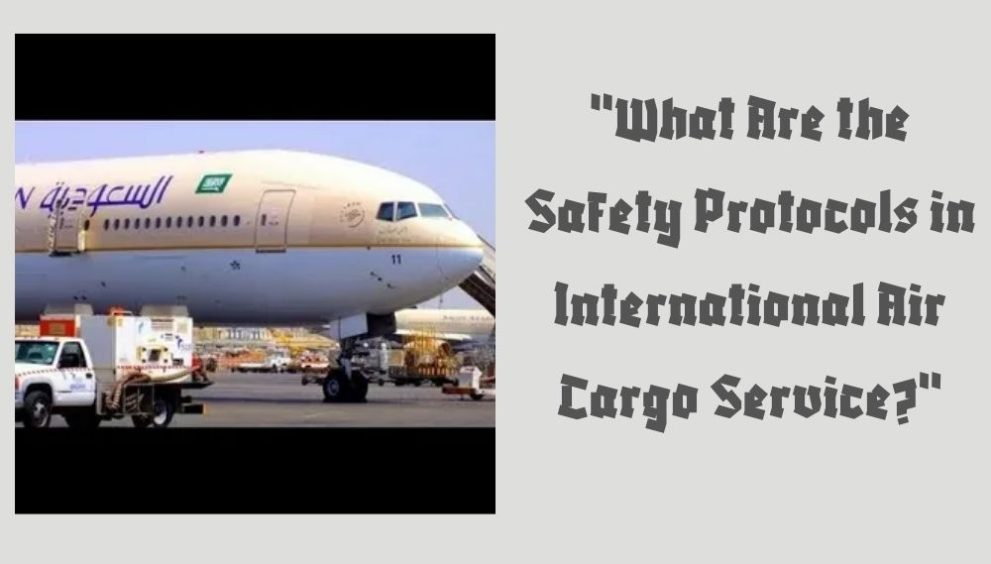What Are the Safety Protocols in International Air Cargo Service?


International air cargo services play a crucial role in moving goods across the globe quickly and efficiently. However, transporting goods by air comes with significant safety challenges. Ensuring that the cargo is safe, secure, and compliant with regulations is essential, particularly when handling hazardous materials or high-value goods. In this article, we will explore the safety protocols that are in place to protect both the cargo and the individuals involved in its transport.
Note: “With international air cargo service in Saudi Arabia, UBLCO (Universal Bridge Logistics Co.) ensured that all shipments met safety and regulatory standards. Their prompt service and professional handling made the process seamless. Trust UBLCO for reliable air cargo services on your next shipment.”
The Importance of Safety in International Air Cargo
Air cargo safety goes beyond protecting the goods being transported; it emphasizes safeguarding the people handling the goods and ensuring that they comply with international regulations. The swift movement of goods and the possibility of dealing with dangerous or hazardous materials heighten the risks in air cargo. Proper safety protocols ensure that handlers manage the cargo correctly, minimize accident risks, and protect everyone involved in the transportation process.
Air cargo safety protocols help ensure:
- Cargo integrity
- Prevention of accidents
- Protection against theft or tampering
- Compliance with international regulations
When cargo involves dangerous goods, such as chemicals, explosives, or perishable items, these protocols become even more critical.
Regulatory Framework for Air Cargo Safety
Several organizations govern international air cargo safety by creating standards and regulations to ensure the safe and secure transport of goods.
International Civil Aviation Organization (ICAO)
The International Civil Aviation Organization (ICAO) is a specialized agency of the United Nations responsible for regulating global civil aviation. ICAO develops guidelines that air cargo service providers must follow to ensure safety and security. One of the critical documents is the ICAO Technical Instructions for the Safe Transport of Dangerous Goods by Air. This document outlines how hazardous materials should be classified, packaged, and documented to prevent accidents.
International Air Transport Association (IATA)
The International Air Transport Association (IATA) is another key player in regulating air cargo safety. IATA’s Dangerous Goods Regulations (DGR) provide specific guidelines for handling, packaging, and labeling dangerous goods. IATA also ensures that airlines and cargo handlers are trained and up-to-date on the latest safety standards. Their regulations are globally recognized and adhered to by air cargo service providers.
The International Air Transport Association (IATA) plays a crucial role in ensuring air cargo safety and efficiency. Firstly, IATA sets the global standards for cargo handling, including the handling of dangerous goods and regulatory compliance. Furthermore, IATA offers training programs for industry professionals to stay updated on safety protocols and best practices. Additionally, IATA works closely with regulatory bodies like ICAO to align industry standards with international regulations. As a result, by following IATA’s guidelines, air cargo providers can enhance their operations, improve safety, and contribute to the smooth functioning of the global air cargo network.
National Regulatory Authorities
In addition to global organizations like ICAO and IATA, each country has its regulatory authorities. For example, in the U.S., the Federal Aviation Administration (FAA) oversees air cargo safety, while the European Union Aviation Safety Agency (EASA) handles similar duties in Europe. These agencies ensure that air cargo operations comply with international safety standards and conduct audits and inspections to ensure safety.
Cargo Screening and Security Measures
Security is a significant concern in air cargo operations. Given the potential for malicious acts, such as terrorism or the introduction of illicit materials, cargo screening is an essential safety measure.
Security Screening and X-ray Inspection
Air cargo is regularly screened to detect threats, such as explosives or unauthorized items. One of the most common methods for screening is X-ray inspection. This allows security personnel to check the contents of cargo without opening the packages, which helps prevent delays and ensures safety.
In addition to X-ray inspection, other screening methods may include physical searches, canine screening, and advanced scanning technologies that can detect various threats, including drugs, weapons, or electronics.
Cargo Security Programs
Many countries require air cargo service providers to implement Cargo Security Programs (CSPs), which establish security standards for handling, storing, and transporting goods. These programs are designed to prevent tampering and ensure that cargo is safe throughout its journey. CSPs include background checks for employees, secure storage areas, and restricted access to cargo facilities.
Authorized Economic Operators (AEO)
To enhance security further, logistics companies and air cargo handlers can apply for Authorized Economic Operator (AEO) status. AEOs are trusted, certified logistics providers who comply with the highest safety and security standards. They receive streamlined customs clearance and faster processing times, which helps ensure that cargo is handled securely and efficiently.
Handling and Transporting Dangerous Goods
Handling dangerous goods, or hazardous materials (DG), is one of the most critical aspects of air cargo safety. These goods are classified into various categories based on their risk level. They can include flammable liquids, radioactive materials, or toxic substances.
Classification and Packaging of Dangerous Goods
Dangerous goods must be securely packaged to prevent leaks, spills, or reactions during transit. Regulations define the appropriate types of packaging and containers for each category of dangerous goods. The cargo must also be labeled with specific symbols that indicate the level of danger, alerting handlers to the associated risks.
Proper classification and packaging are crucial to ensuring the safe transport of dangerous goods, preventing harm to people or the environment.
Documentation and Compliance
Each dangerous goods shipment must include a Dangerous Goods Declaration (DGD), which provides detailed information about the shipment’s contents, handling instructions, and emergency contacts. This declaration ensures that everyone involved in the transport process is aware of the cargo’s potential hazards and can take the necessary precautions.
Compliance with these regulations is critical. Failure to adhere to proper documentation or packaging standards can result in fines, delays, and potential safety hazards.
Risk Management and Safety Protocols During Transport
Safety protocols are implemented throughout the transport process to minimize risks and protect both the cargo and the people involved.
Cargo Handling Procedures
Proper cargo handling is a key component of air cargo safety. Handlers must load and unload cargo carefully to prevent accidents and damage. They must also secure cargo properly inside the aircraft to prevent movement during flight, which could lead to accidents or delays. Air cargo handlers receive training to follow detailed procedures for loading, unloading, and securing cargo.
Flight Crew and Ground Crew Training
All personnel involved in the air cargo process, including the flight crew and ground crew, receive training to handle various emergency situations. This training covers how to respond to hazardous material spills, fires, and other in-flight emergencies. Crew members also learn to recognize security threats and take immediate action when necessary.
Emergency Response Plans
Airlines and cargo companies must have well-established emergency response plans to deal with incidents that may occur during transport. These plans outline procedures for handling hazardous material spills, fires, or accidents. Emergency response teams are trained to react quickly to contain and mitigate any risks, ensuring the safety of the crew, passengers, and the cargo.
Technology and Innovations in Air Cargo Safety
Technology has revolutionized air cargo operations and safety protocols. New advancements help improve safety, enhance efficiency, and reduce human error.
Real-Time Tracking Systems
Real-time tracking has become an essential safety feature in air cargo services. Through GPS and RFID technology, customers and cargo providers can monitor shipments throughout their journey. This allows for greater transparency and ensures that any issues or delays are identified early, allowing for quick corrective actions.
Automated Cargo Handling
Cargo handling increasingly applies automation to reduce human error and improve efficiency. Automated systems manage the loading, unloading, and sorting of cargo, ensuring accurate and secure processing of goods. These systems also ensure that hazardous goods are handled according to the necessary safety protocols.
Conclusion
Safety in international air cargo is vital for protecting the cargo, the people handling it, and the environment. By following strict protocols set by ICAO, IATA, and national authorities, air cargo service providers ensure the secure and efficient transport of goods. Screening procedures, hazardous material handling, and risk management are all key components of the broader safety framework that ensures safe air cargo operations.
As the industry grows, technology, improved training, and stronger security measures will become even more crucial in maintaining safety. Understanding and following these safety protocols is essential for everyone involved in air cargo services, from airlines and logistics providers to customers and regulatory authorities. With these measures, the international air cargo industry can continue to grow, minimizing risks and ensuring the safe transport of goods worldwide.
In conclusion, air cargo safety plays a vital role in ensuring the smooth and secure transport of goods worldwide. As the industry evolves, it becomes increasingly important to adopt advanced technologies, rigorous protocols, and comprehensive training to mitigate risks. Moreover, compliance with international regulations ensures that both the cargo and personnel remain protected. Therefore, by continuously improving safety measures, the air cargo industry can effectively address emerging challenges while maintaining the integrity and safety of global shipments.
For More Insightful Articles Related To This Topic, Feel Free To Visit: bloggingshub.com













